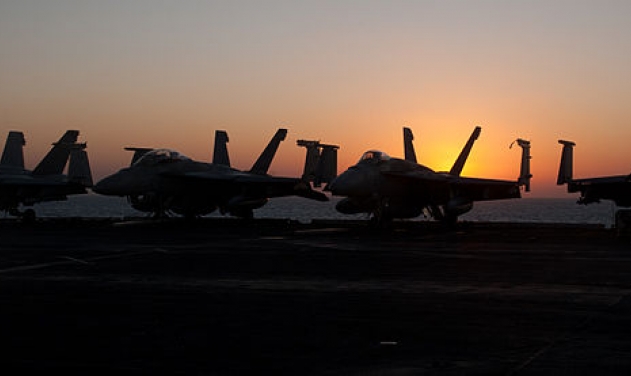US Navy Tests Innovative Technology To Streamline Aircraft Carrier Landing Process

The US Navy tested a technology innovation that makes landing fixed-wing aircraft aboard an aircraft carrier easier.
The Maritime Augmented Guidance with Integrated Controls for Carrier Approach and Recovery Precision Enabling Technologies, or Magic Carpet, is advanced technology designed to streamline the aircraft carrier landing process, which provides improved safety, efficiency and success rates in recovering fixed-wing aircraft on board aircraft carriers, according to the Navy press release.
"We are testing the initial fleet release version," said Lt. Christopher Montague, a project officer for Magic Carpet attached to VX-23. "It makes the job (of landing on a carrier) a lot easier. We have taken a number of leaps in what we can do with flight control technology to be more accurate and use fewer passes to successfully trap an aircraft."
On typical carrier landings, pilots must align glide slope, angle of attack and line up, often making up to hundreds of individual adjustments in order to safely land. Magic Carpet seeks to simplify this process by reducing the pilot's work load.
"With the technology, we decoupled the glide slope, angle of attack and line up into three separate pieces," said Capt. David Kindley, the F/A-18 & EA-18G program manager. "Before, if a pilot made one small change to any of these it would affect all the other things. With Magic Carpet, if the pilot wants to adjust glide slope, he just pushes the stick without changing the power or anything else."
VX-23 tested the initial version of the software April 20-23, 2015 aboard the aircraft carrier USS George H.W. Bush (CVN 77).
"On CVN 77, we were just trying to test the feasibility of the software," said Kevin Teig, the lead flight test engineer. "We were also looking for deficiencies and ways to improve. One of the refinements we made for this test iteration was to fine tune the gains and sensitivity of the flight control and see how the system handles."
Now, VX-23 pilots are testing a new feature, an improved head-up display (HUD) on the F/A-18E/F Super Hornet and EA-18G Growler.
"The previous models were designed to land on a stationary airfield," said Montague. "Since carriers are frequently on the move, we designed it to better adapt and compensate for the movement. It takes all the technology we have in the Super Hornet and tailors it in one specific area."
Ultimately, one of the goals of the Magic Carpet software is to reduce training time for future pilots.
"The culture these days is that there are a lot of young kids who have grown up with video games and are used to quick hand-eye coordination," said Teig. "If we give them intuitive software and enhanced HUD symbology, such as with Magic Carpet, learning to fly the ball and make corrections with this control method will be very similar. It will make training a lot faster and easier for the new and upcoming pilots."
"Magic Carpet is an evolutionary improvement in aircraft carrier landings," said Vice Adm. Mike Shoemaker, commander, Naval Air Forces. "This technology innovation will ease pilot workload, improve overall recovery time and reduce tanker requirements. These significant changes will make naval aviation even more effective and efficient and improve the offensive capability of the carrier strike group."
The final fleet release version of the technology is expected to come out in 2019.









